|

Abstracts
Print-friendly
version
*speaker (co-authored abstracts)
 Spotted
seatrout Spawning Requirements & Essential Fish Habitat: A Microhabitat
Approach Using Hydrophones Return
to Top Spotted
seatrout Spawning Requirements & Essential Fish Habitat: A Microhabitat
Approach Using Hydrophones Return
to Top
Donald M Baltz (Coastal Fisheries Institute
& DOCS, Louisiana State University)
A microhabitat approach using hydrophones to identify important activities
can yield a fish's eye view of its habitat requirements. At the finest
scale, the microhabitat of an individual is the site it occupies at a
point in time. Site selection presumably optimizes net energy gain but
is controlled in combination by physiological constraints, prey distributions,
foraging success, competitor densities, and predation pressures. Because
individuals select similar microhabitats, many independent measurements
and associated environmental variables define a population's responses
to environmental gradients. Spawning site variables include temporal,
spatial, and microhabitat data: depth, distance from shore, substrate,
turbidity, salinity, temperature, DO, current velocities, and some measure
of spawning aggregation size. Habitat Suitability is an index of Use/Availability
that ranges from zero (intolerable) to one (optimal). Resource Use is
a probability statement, given the presence of spawning, and Resource
Availability is a probability statement, regardless of the presence of
spawning: Suitability=P(E|F)/P(E). Previous research on spawning spotted
seatrout in Louisiana identified points that were selected and avoided
along salinity, depth, substrate, and velocity gradients. Relatively deep,
moving waters with salinities of 14-23 and temperatures of 29-33 C were
selected. Spawning sites shifted with the salinity gradient, indicating
that environmental conditions were more important than location fidelity.
Sound Intensity (db re 1 micro pascal) may be used to estimate Source
Level, after correcting for one-way spreading loss (i.e., 20 log [depth
in meters]), if distance to the spawning aggregation is known and provides
a continuous-variable estimate of aggregation size for statistical modeling.

 Creating
a Web-based Library of Underwater Biological Sounds Return
to Top Creating
a Web-based Library of Underwater Biological Sounds Return
to Top
Jack W. Bradbury and Carol A.Bloomgarden* (Macaulay Library of
Natural Sounds, Cornell Laboratory of Ornithology)
Establishing an archive of fish and other underwater biological sounds
will meet many of the long-standing challenges faced by marine acousticians
- the restoration and preservation of their recordings, easy access to
the sounds for analysis, and the storage of hundreds of hours of passive
recordings in a digital format. Researchers will be able to annotate their
sounds through an online database application, summarize search results
in exportable tables and maps, and download copies of recordings for research,
teaching, and conservation. The MLNS is committed to dual goals of maintaining
open access to allow other researchers to listen and help identify sounds,
while protecting recordists' copyrights and restricting access during
the publication process. Detailed and extensive metadata are needed, however,
to create the functionality such an archive requires.

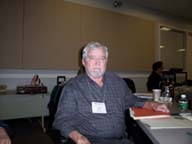 Use
of ROVs as a platform for passive acoustics: characterization of ROV noise
generation Return
to Top Use
of ROVs as a platform for passive acoustics: characterization of ROV noise
generation Return
to Top
Rodney Rountree (UMass-Dartmouth), Joseph
E. Blue* (Leviathan Legacy, Inc. ) and Francis Juanes (UMass-Amherst)
The use of passive acoustics for tracking was developed for naval warfare
during and before WW II. A passive acoustics tracking system was implemented
on torpedoes for homing on ships and submarines. This system will be discussed
along with its limitations for homing on soniferous fish when mounted
on Remotely Operated Vehicles (ROVs). This system was developed before
the advent of small, fast computers and was implemented with electronics
that are now known as operational amplifiers. The theory of these analog
systems will be discussed along with digital methods that now can make
computer implementations of this type of system and modifications of it
feasible for implementation on ROVs. Adequate Signal-to-Noise ratios are
require for implementing these techniques. Reaction of fish to a ROV during
Stellwegen Bank dives will be shown as that may present a problem in attempting
to get good data from some types of fish. Noise from ROV thrusters using
3 hydrophones configure to track soniferous fish was measured during dives
on the Stellwegen Bank. The ROV employed was too noisy for getting good
signatures from most fish. The noise measurements are to be presented.
Some types of loud fish that may be detected above the ROV noise are discussed.

 Potential
for coupling of underwater TV monitoring with passive acoustics Return
to Top Potential
for coupling of underwater TV monitoring with passive acoustics Return
to Top
Charles A. Barans and Myra C. Brouwer*
(South Carolina Marine Resources Research Institute)
The temporally and spatially fluid nature of fish associations often
confuses interpretations of their underwater sounds. Ideally, visual confirmation
of the sound producers and any behaviors associated with sound making
should complement acoustic data. The South Carolina Marine Resources Division
(MRD) established an artificial reef structure and underwater television
(UWTV) system for monitoring reef fishes at a site approximately 72 km
off Georgia. Transmission of digital image data was from a bottom-mounted
camera system via an established microwave linkage to shore. This study
was part of the South Atlantic Bight Synoptic Offshore Observational Network
(SABSOON) project, a collaborative effort to study oceanographic conditions
and fisheries resources that inhabit continental shelf waters. The long-term
goal of this research is to evaluate UWTV for providing fishery managers
real-time data on reef fish assemblages to establish and/or modify management
regulations. Underwater observations were conducted daily for a year and
a half. We documented a variety of vertebrate and invertebrate species
associated with seasonal temperatures changes. The identification of fish
species has been difficult to sort out with acoustic records in complex
and highly diverse environments such as natural and artificial reefs.
As with some hydroacoustic records, small fish were not easily identified
with UWTV, especially if more than one species was present. Although many
of the presently known sonic signatures have been corroborated with visual
observations, many more are needed to assist in interpretations from randomly
placed hydrophones, especially in complex habitats with many interacting
species of vertebrates and invertebrates.

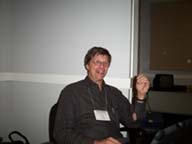 Application
of passive acoustic methods for automatic detection, location and tracking
of whales Application
of passive acoustic methods for automatic detection, location and tracking
of whales
Return
to Top
Christopher W. Clark (Cornell University)
All baleen whales produce species specific sounds and at least five
species produce long, patterned, hierarchically organized sequences of
sounds referred to as songs. Baleen whale distribution and relative abundance
estimates are traditionally based on visual surveys from vessels and/or
airplanes. This approach is limited by visibility conditions and access
to observation platforms. Acoustic monitoring using either single or multiple
sensors offers a significant improvement by increasing spatial and temporal
sampling. Signal processing techniques allow automatic detection, location
and tracking. Throughout the last 20 years acoustic hardware and software
tools have been developed and applied to survey whale species and gain
insights into natural behaviors. This includes the use of Navy SOSUS arrays
to detect and estimate numbers of vocal animals by species throughout
an ocean basin, autonomous seafloor sensors to detect, locate and track
species of interest in regions, and sparse or towed hydrophone arrays
to detect, locate and track species of interest in specific study areas.
For at least four species, SOSUS data reveal annual seasonal and large
geographic fluctuations reflecting migration, feeding and breeding patterns.
For bowheads combined visual-acoustic efforts have lead to calculation
of a robust population assessment and trend over a 20-year period, as
well as understandings of acoustic functions. For blue and fin whales,
passive acoustics in combination with visual, biopsy, Photo-ID, and prey
field surveys is beginning to reveal details of vocal function, details
that are critical for interpreting and evaluating acoustic data alone.

 Locating
sciaenid spawning aggregations in anticipation of harbor modifications,
and reactions of spotted sea trout spawners to acoustic disturbance Return
to Top Locating
sciaenid spawning aggregations in anticipation of harbor modifications,
and reactions of spotted sea trout spawners to acoustic disturbance Return
to Top
Mark R.Collins* (Marine
Resources Research Institute, South Carolina Dept. of Natural Resources),
Bridget Callahan, Bill Post and Amanda Avildsen (SCDRN)
Estuarine-dependent sciaenids are the most economically important
fishes in the Savannah River (SC/GA, USA) estuary. Plans for major modifications
and deepening of the Savannah Harbor and shipping channel have generated
special concerns about exacerbating sciaenid spawning stock reductions
through interference with spawning aggregations. A passive acoustic survey
designed to define the geographic and temporal distribution of spawning
aggregations of the most important sciaenid species, determine site fidelity
between years, characterize spawning habitats, and determine effects of
dredging activity on aggregations was therefore conducted during 2000-2001.
Of the economically important sciaenids encountered, six primary spawning
sites were identified for spotted seatrout, one for weakfish, and one
for black drum. No large red drum spawning aggregations were located,
but individuals or small groups of drumming males were found. Sites for
all species were in salinities > 16 ppt, and all were within 12.2 river
km of the river mouth. Time of day of spawning appeared to be anchored
around sunset with peak activity from about 1 hr before through about
3 hr after. There was considerable seasonal overlap in spawning activity
among species, and in the lower 2 river km there appeared to be spatial
overlap. However, on a finer scale (hundreds of meters) there was little
or no overlap. Spotted seatrout and red drum ignored ships and dredging
but ceased drumming when bottlenose dolphin passed by. Because two (and
possibly three) of the species appear to aggregate around structures,
removal of these structures during deepening and channelization operations
may have a negative impact.

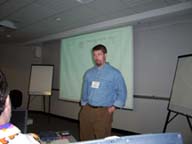 Characterization
of sounds and their use in two sciaenid species: weakfish and Atlantic
croaker Return to Top Characterization
of sounds and their use in two sciaenid species: weakfish and Atlantic
croaker Return to Top
Martin A Connaughton*(Washington
College), Michael L. Lunn (Phildelphia College of Osteopathic Medicine),
Micheal L. Fine (Department of Biology, Virginia Commonwealth University)
and Malcolm H. Taylor, (College of Marine Studies and Department of Biological
Sciences, University of Delaware)
Weakfish, Cynoscion regalis, and Atlantic croaker, Micropogonias
undulatus, produce sound with bilaterally paired, extrinsic sonic
muscles. In weakfish, only the male bears sonic muscles and produces sound:
staccato bursts of 6-10 individual pulses at a repetition rate of 23.3
pulses per second (pps) at 21-23ÉC. Field recordings from Delaware Bay
indicated that sound production was highly seasonal and coincided with
the spawning season, and was most intense in the evening, the time of
greatest spawning activity. Identical sounds were recorded during captive
spawning trials, where sound production ceased prior to gamete release,
which was apparently synchronized by body contact. The number of bursts
per minute produced by a given male remained relatively constant during
the course of an evening, regardless of the proximity of a spawning event.
In Atlantic croaker, both males and females bear sonic muscles and will
produce fright response sounds. However, in preliminary captive spawning
trials, only the male produced courtship sounds. Croaker sounds consist
of a smaller number of pulses per burst, 1-9 in fright response sounds
and 1-3 in courtship sounds. The repetition rate for fright response sounds
was much higher (30pps) than for courtship sounds (5.4pps). Dominant frequency
of fright response sounds decreased with length (650-450Hz for 23-30cm
fish at 21ÉC), and though only one fish was recorded during captive spawning
trials, it appears that the frequency of these calls is much lower than
those of fright response sounds (300Hz for a 32.5cm fish).

 Detection
and characterization of yellowfin and bluefin tuna using passive acoustical
techniques Return to Top Detection
and characterization of yellowfin and bluefin tuna using passive acoustical
techniques Return to Top
Scott Allen (University of New
Hampshire, Center for Ocean Engineering) and David Demer* (NMFS
/ Southwest Fisheries Science Center, La Jolla, CA )
Underwater sounds generated by Thunnus albacares and Thunnus
thynnus were recorded and studied to explore the possibility of passive-acoustical
detection. Tuna vocalizations were recorded at the Monterey Bay Aquarium,
Monterey, California, and Maricultura del Norte in Ensensada, Baja California,
Mexico. At both locations, the most prevalent sounds associated with tuna
were low-frequency pulses varying from 20 to 130 Hz, lasting about 0.1
seconds, and usually single and unanswered. A behavior similar to coughing
was coincident with these sounds: the animal's mouth opened wide with
its jaw bones extended and its abdomen expanded, then contracted abruptly.
On one occasion in Mexico, this behavior and associated noise were simultaneously
recorded. The center frequencies of these vocalizations may vary as the
resonant frequencies of the tuna's swim bladder, suggesting a passive-acoustical
proxy for measuring the size of tuna. Matched-filter and phase-difference
techniques were explored as means for automating the detection and bearing-estimation
processes.
Passive-
and active-acoustical monitoring of marine life using multi-instrumented
buoys Return to Top
David Demer* (NMFS/Southwest
Fisheries Science Center, La Jolla, CA ), Derek Needham, (Sea
Technologies Services, Cape Town, South Africa), and Stephane Conti (Southwest
Fisheries Science Center)
For over a decade, the Antarctic Treaty's Committee for the Conservation
of Antarctic Marine Living Resources has pioneered the ecosystem approach
to fisheries management. In support of this effort, the U.S. Antarctic
Marine Living Resources Program investigates responses of krill predators
to changes in the availability of their food. One challenge of this investigation
is to temporally and spatially match observations of predators and their
prey. Towards this end, the Advanced Survey Technologies Program at Southwest
Fisheries Science Center has developed multi-instrumented, remotely-monitored,
light-weight, low-cost buoys to provide long time-series measurements
of krill availability and predator activities in the near-shore area of
Cape Shirreff, Livingston Island, Antarctica. Prototype buoys have recently
been deployed with a 300 kHz acoustic Doppler current profiler to measure
currents, volume backscatter, water temperature, pitch, roll, and bearing;
and 38 and 200 kHz echosounders. Passive-acoustical detection and bearing
estimation systems have also been developed and tested for integration
into the buoys. Additionally, the buoys include a computer, GPS, radar
reflector, strobe, radio-modem, and power management circuit. Remote control
of the instrumentation and real-time monitoring of data is accomplished
by radio-telemetry between the buoy and a distant land-station. Thus,
a safe and cost-effective method has been developed for remotely monitoring
the presence of vocalizing whales and seals in harsh environments, as
well as characterizing the variability in the prey available to them and
their oceanographic habitat. The first deployments in February 2002 have
garnered new information about the temporal variations in krill dispersion
and possible environmental forcing.

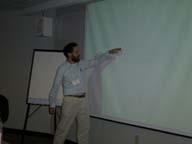 Acoustic
competition in the gulf toadfish Opsanus beta: Crepuscular changes and
acoustic tagging Return
to Top Acoustic
competition in the gulf toadfish Opsanus beta: Crepuscular changes and
acoustic tagging Return
to Top
Michael L. Fine* (Virginia Commonwealth University) and
Robert F. Thorson
Nesting male gulf toadfish Opsanus beta produce a boatwhistle advertisement
call used in male-male competition and to attract females and an agonistic
grunt call. The grunt is a short-duration pulsatile call, and the boatwhistle
is a complex call typically consisting of zero to three introductory grunts,
a long tonal boop note and zero to three shorter boops. The beginning
of the boop note is also gruntlike. Anomalous boatwhistles contain a short
duration grunt embedded in the tonal portion of the boop or between an
introductory grunt and the boop. Embedded grunts have sound pressure levels
and frequency spectra that correspond with those of recognized neighbors,
suggesting that one fish is grunting during another's call, a phenomenon
here termed acoustic tagging. Snaps of nearby pistol shrimp may also be
tagged, and chains of tags involving more than two fish occur. The stimulus
to tag is a relatively intense sound with a rapid rise time, and tags
are generally produced within 100 ms of a trigger stimulus. Time between
the trigger and the tag decreases with increased trigger amplitude. Tagging
is distinct from increased calling in response to natural calls or stimulatory
playbacks since calls rarely overlap other calls or playbacks. Tagging
is not generally reciprocal between fish suggesting parallels to dominance
displays.

 Multihydrophone
localization of low frequency broadband sources Return
to Top Multihydrophone
localization of low frequency broadband sources Return
to Top
Steve Forsythe (NUWC
Newport)
In theory, one can use multiple hydrophones distributed in space to
localize a source position/direction: using time-of-flight differences
among the hydrophones, generate multiple hyperboloids then solve for the
surfaces' intersection to give a unique position for the source, perhaps
in the least-squares sense. In practice, this is difficult for low frequency
signals generated by fish (thumps, etc.) because the onsets of the signals
are not well defined. By using cross correlations among the received signals
as a "fuzzy" measure of time difference it is possible to do the equivalent
of the intersecting hyperboloids calculation with an uncertain measure
of time differences, giving the equivalent of a probability density of
source location over a predetermined space of a priori possible locations.

 Passive
Acoustic Field Research on Atlantic Cod, Gadus morhua L. in Canada Return
to Top Passive
Acoustic Field Research on Atlantic Cod, Gadus morhua L. in Canada Return
to Top
Susan Fudge* and George
A. Rose (Memorial University of Newfoundland)
Passive acoustics is a relatively new field of
research in Newfoundland and Canada. The vanguard work has been on Atlantic
cod (Gadus morhua) and in particular on spawning behaviour. Cod
spawn in large aggregations with sexually diverse behaviours. Males appear
to hold the spawning location while females come and go (batch spawners).
Sonar tagging has shown that some cod return to the same spawning grounds
in subsequent years. Atlantic cod are known to exhibit differences in
spawning behaviours among sub-stocks and to have distinct spawning behaviours
among ages and sexes. The importance of the social behaviour of cod during
spawning is important not only to fisheries production but also to conservation
and management. That cod produce and detect sound during spawning has
long been recognized from lab experiments. However, ours is the first
attempt in Canada to document the sounds made during spawning at sea and
to relate these to spawning behaviour. A working hypothesis is that male
sounds are characteristic of spawning aggregations and assist in group
identification and membership. Our study encompasses two of the largest
spawning components of cod in Newfoundland waters. Preliminary results
are presented to illustrate recorded sounds of spawning cod.

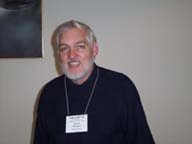 Passive
acoustic transects: Mating calls and spawning ecology in East Florida
sciaenids Return
to Top Passive
acoustic transects: Mating calls and spawning ecology in East Florida
sciaenids Return
to Top
Grant Gilmore (Dynamic Corp. Kennedy Space
Center)
Experimental explorations in nocturnal fish call distributions were
first made in 1976 in the Indian River Lagoon in East Florida. This eventually
developed into a systematic survey of estuarine fish calls with a post
doctoral fellow, Hin Kiu Mok at the Harbor Branch Oceanographic Foundation.
All sciaenid calls were identified to species within a survey region and
correlated with egg/larval abundance. Sound attenuation experiments were
also conducted to allow accurate isolation of call aggregation sites.
This resulted in a publication (Mok and Gilmore 1983) describing sciaenid
calls in the black drum, Pogonias cromis, silver perch, Bairdiella
chrysoura, and spotted seatrout, Cynoscion nebulosus. Acoustic
studies of these sciaenid populations continued increasing in intensity
with a multi-disciplinary study of the spotted seatrout from 1990 to1994.
Neural networks were developed to allow computer software to identify
specific fish sounds, as well as detailed hydrological studies of spawning
sites, larval ecology and juvenile settlement patterns. Remote recording
devices were designed and deployed which allowed up to one week of preprogrammed
ambient sound recordings on digital recorders. Spawning site distribution
was mapped in detail using acoustic transects which allowed a model of
spawning site choice to be developed. These studies continue with most
work taking place in the northern Indian River Lagoon system, including
the Mosquito Lagoon, a protected estuary. Presently NASA is supporting
the development and deployment of passive acoustic technologies to monitor
aquatic acoustic organisms within the protected waters of the Kennedy
Space Center.

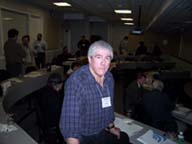 The
use of passive acoustics to identify a haddock spawning area Return
to Top The
use of passive acoustics to identify a haddock spawning area Return
to Top
Tony Hawkins (FRS Marine
Laboratory, Aberdeen, Scotland)
The codfish family (Gadidae) contains several vocal species. One of
them is the haddock, Melanogrammus aeglefinus, a common food fish
of the North Atlantic The haddock produces a range of sounds in different
contexts. During courtship and spawning, a succession of sounds are produced
by males ranging from short series of slowly repeated 'knocks' to longer
sounds where the knocks are repeated very rapidly. Wavelet analysis has
been used to define the characteristics of haddock sounds and even to
discriminate between sounds from different individuals.
Haddock are currently fished beyond safe
biological limits. Their spawning grounds may be closed to fishing in
the future to limit damage. Haddock are believed to spawn offshore, but
reports also suggest that spawning may take place inshore. A search for
spawning haddock was carried out in coastal waters using passive listening
to detect their characteristic sounds. By this means an aggregation of
spawning fish was located in a subarctic Norwegian fjord. Sound production
was most intense at night, with the calls of many fish overlapping to
give a rumbling sound. Spawning appeared to take place on the seabed,
with the males spaced out in a matrix of territories. Repeat surveys showed
that the spawning concentrations occurred in the same location over two
successive years.
The wider use of passive listening, and the
application of techniques like wavelet analysis which allow unambiguous
identification, may greatly assist in the search for the spawning areas
of commercially important food fishes.

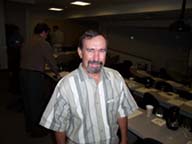 Using
a towed acoustic array to survey drum spawning sites in the Gulf of Mexico
Return to Top Using
a towed acoustic array to survey drum spawning sites in the Gulf of Mexico
Return to Top
Scott Holt (University
of Texas Marine Science Institute)
A towed hydrophone array was used to survey for red drum (Sciaenops
ocellatus) spawning sites along central Texas coast in the western
Gulf of Mexico. The array is composed of an eight-element array in an
80 meter cable and a 200m towing cable. The array was towed at approximately
3.5 kts. from a 105 foot stern trawler during the known spawning time
(both season and daily) of red drum. Red drum produce a characteristic
drumming or knocking sound during courtship and spawning. Although the
pulse pattern of the call is variable, the fundamental frequency is consistently
around 140-160 Hz. The occurrence of red drum spawning activity was determined
by listening to the tapes for characteristic sounds and by examination
of spectral analysis of the data stream. We estimated that clearly identifiable
calls of individual red drum could be heard over a distance of 80-100m
and convergent sounds of numerous red drum over greater but undetermined
distances. Individual red drum were heard regularly along the tow track
but were seldom heard in close proximity to each other. Although more
drumming activity was heard in the vicinity of tidal inlets, drumming
occurred over a relatively wide area of the shallow coastal waters. The
temporal nature of spawning activity (red drum only spawn during a few
hours in the evening) and our limited knowledge of the exact reproductive
strategies of red drum make data interpretation somewhat problematic.

 Passive
detection and localization of transient signals from marine mammals using
widely spaced bottom mounted hydrophones in open ocean environments
Return to Top Passive
detection and localization of transient signals from marine mammals using
widely spaced bottom mounted hydrophones in open ocean environments
Return to Top
Susan Jarvis* and David Moretti
(Naval Undersea Warfare Center Division Newport)
The Navy undersea acoustic ranges such as
the Atlantic Undersea Test and Evaluation Center (AUTEC) provide broadly
spaced hydrophone arrays that are traditionally used to track undersea
and surface vehicles which have been equipped with acoustic pingers. Increasingly,
this broad infrastructure is being applied to non-traditional tracking
problems. The Marine Mammal Monitoring on Navy Undersea Ranges (M3R) program,
funded by the Office of Naval Research, is working to develop tools to
detect and track marine mammals. The initial development is taking place
at AUTEC where a total of 79 broad-band hydrophones are deployed. Passive
acoustic data is recorded and used in the development of marine mammal
detection and tracking algorithms. This presentation describes the detection
and tracking algorithms currently under development for the M3R passive
acoustic system and the complementary visual sighting information collected
by the AUTEC marine mammal environmental compliance program.

 Fish
courtship and mating sounds Fish
courtship and mating sounds
Phillip Lobel (Boston University)
This presentation will show the sonic behavior of several coral reef fishes
and freshwater cichlids. The emphasis will be on courtship and reproductive
sounds, which are amenable to monitoring by passive acoustic detection.
Recordings were made in the field using an underwater video camera coupled
to a hydrophone for synchronous audio-video recording of behavior.
Synchronized
underwater audio-video recording
Phillip Lobel (Boston University)
This presentation will review my experience trying to record fishes underwater
using a video-hydrophone system and other gear.

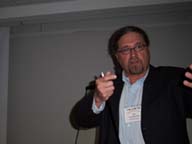 Use
of passive acoustics to identify essential fish habitats in North Carolina
Return to Top Use
of passive acoustics to identify essential fish habitats in North Carolina
Return to Top
Joseph J. Luczkovich* ( Department
of Biology/Institute for Coastal and Marine Resources, East Carolina University)
and Mark W. Sprague (Department of Physics, East Carolina University)
Sounds produced by spawning fishes in Pamlico Sound have been recorded
both under captive conditions and in field surveys. Sonobuoys and hydrophone
passive acoustic surveys, ground-truthed by means of the captive recordings,
showed the timing and location of spawning sites for four species in the
family Sciaenidae: red drum (Sciaenops ocellatus), spotted seatrout
(Cynoscion nebulosus), weakfish (Cynoscion regalis), and
silver perch (Bairdiella chrysoura). The calls are produced by
males and are species-specific, suggesting that the calls are used for
advertisement to attract females. Using the UNCW/NURC Phantom S2 ROV with
a calibrated hydrophone, we have videotaped silver perch during their
mating period, simultaneously recorded their calls, and measured the sound
pressure level (SPL) of an individual near the hydrophone. The sounds
were detected first in the early evening, but increased in loudness after
dark (SPL reaching 136 dB re 1 mPa). The SPL of the spawning choruses
are correlated with egg production, suggesting that the passive acoustic
method can be used to estimate fish abundance. Other species were identified
in the surveys, including toadfish (Opsanus tau), striped cuskeel
(Ophididon marginatum), snapping shrimp (Alpheus sp.), and
bottlenose dolphin (Tursiops truncatus). These passive acoustics
surveys revealed interesting behavioral interactions as well, with spotted
seatrout and weakfish apparently competing for spawning sites, and silver
perch showing ?acoustic avoidance? of bottlenose dolphins. These passive
acoustic surveys in Pamlico Sound have proven the feasibility of determining
critical spawning habitats of sciaenid fishes, and have revealed interesting
insights into the biology of these species as well.

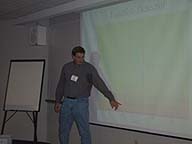 New
technologies for passive acoustic detection of fish sound production
Return to Top New
technologies for passive acoustic detection of fish sound production
Return to Top
David Mann (University of South Florida)
I will describe progress in developing instrumentation
for passive acoustic detection of fish sounds. Early attempts at passive
acoustic detection involved developing a largely analog system that would
detect sounds that were above some background level and storing the time
of occurrence and sound duration (actual sound data were not stored).
From these data, the rate of sound production of different species' sounds
could be determined. Recent digital systems use many of the same techniques
to detect sounds, but can also store more information such as a time stamp
and an actual sound recording segment. I will present data on fish sound
production using new passive digital signal processing dataloggers produced
by Tucker-Davis Technologies. These dataloggers are very flexible in how
signals are detected and processed. These dataloggers represent the next
step in developing systems for fisheries bioacoustics.Ultimately fisheries
bioacoustics should move the way of fisheries acoustics where the signal
output is not the actual sound data, but the locations and intensity of
fish spawning.

 Is
acoustic calls a premating reproductive barrier between two north-east
Atlantic cod (Gadus
morhua) groups? A Review Return
to Top Is
acoustic calls a premating reproductive barrier between two north-east
Atlantic cod (Gadus
morhua) groups? A Review Return
to Top
Jarle Tryti Nordeide*
(Bodø Regional University, Norway) and Jens LossFinstad
(Department of Fisheries and Marin Biology, University of Bergen, Norway
)
This study examines the hypothesis that spawning calls of a migratory
and a stationary species of Atlantic cod (Gadus morhua), which are sympatric
during the spawning season, is a premating reproductive barrier. Firstly,
a hushed hubbub was recorded at a major spawning ground during spawning.
Secondly, harmonic frequency and duration of calls from cod kept in tanks
varied a lot between individual cod, from 42 to 79 Hz and from 0.11 to
1.25 s, respectively. Having passed the two first obstacles the hypothesis
has so far failed to pass the third hindrance. No difference has yet been
found in mean harmonic frequency of grunts from stationary (55.7 Hz) and
migratory (53.4 Hz) cod, in mean duration of their calls (stationary:
0.33 s, migratory: 0.31 s), nor in multivariate analysis of their oscillograms.
However, these analytic tools are rather rough and further analysis are
required before final conclusions are drawn.

 A
remote-controlled instrument platform for fish behaviour studies and sound
monitoring Return
to Top A
remote-controlled instrument platform for fish behaviour studies and sound
monitoring Return
to Top
Bjørn Totland, Ingvald Svellingen,
and Jan Tore Øvredal*
(Institute of Marine
Research, Fish Capture Division, Norway)
In order to allow fish sounds to be recorded in situ, a new remote-controlled
instrument platform was developed. The platform consists of two main units;
an underwater electronics bottle capable of operating at a depth of 500
m, and a surface radio telemetry buoy. The underwater unit houses a single-board
computer for sound recording, controlling I/O to various instrument functions
and logging data from environmental sensors. The set-up in the underwater
unit can easily be modified to provide support for the instrumentation
needed for a wide range of behavioural studies. The unit is fitted with
several sub-sea connectors on its front lid for video cameras, pan/tilt
unit, hydrophones, artificial light, echo-sounder, etc., making it suitable
for a variety of experiments. A cable connects the underwater unit to
the surface buoy. The buoy contains a video transmitter and a full-duplex
115 kbps UHF data link that enables the instrument platform to be operated
from a base-station at a distance of up to two nautical miles with video
transfer, and up to 10 miles with data-link only. The platform has been
successfully used to record fish sounds in combination with video observations.
The advantages of a remote-controlled instrument platform over a system
with long cables have been clearly demonstrated in these studies.

 Applications
of underwater acoustics data in fisheries management for spotted seatrout,
Cynoscion nebulosus, in estuaries of South Carolina
Return to Top Applications
of underwater acoustics data in fisheries management for spotted seatrout,
Cynoscion nebulosus, in estuaries of South Carolina
Return to Top
William A.Roumillat*, Myra C.Brouwer (South Carolina
Marine Resources Research Institute)
We have collected information on the spawning behavior of spotted
seatrout in coastal South Carolina since 1990. Spotted seatrout exhibit
group-synchronous development and indeterminate fecundity; that is, gametes
are released in batches and total fecundity is not fixed prior to the
onset of the spawning season. During the summer, male spotted seatrout
produce "drumming" sounds that are related to spawning behavior.
By listening to these sounds using hydrophone equipment, we determined
the locations, seasonality and diurnal periodicity of spawning aggregations
in Charleston Harbor. Behavior patterns based on acoustic data enabled
us to target females in imminent spawning condition, then carry out oocyte
counts for batch fecundity (BF) estimation. Additional random sampling
provided data to estimate spawning frequency (SF) for each of the three
dominant year-classes (ages 1-3) in our waters. Ultimately, our annual
fecundity (AF) estimates for each age class will faciilitate management
of this species in South Carolina. BF varied significantly among year-classes.
Female length, weight (ovary-free) and age explained 69%, 68% and 59%
of the variability in BF, respectively. Monthly SF varied over the season
for each age class. We summed the products of mean monthly BF and corresponding
monthly SF to arrive at AF estimates of 3.2, 9.5 and 17.6 million oocytes
for age classes 1-3, respectively. Age explained 98% of the variability
in AF. These ages contributed an average of 25%, 34% and 19% to the overall
reproductive effort during a season. Based on predicted AF values, ages
4 and 5 each contributed about 11%.

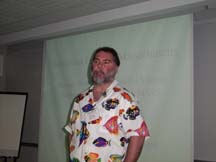 Soniferous
fishes of Massachusetts Return
to Top Soniferous
fishes of Massachusetts Return
to Top
Rodney Rountree* (University of Massachusetts-Dartmouth)
and Francis Juanes (University of Massachusetts-Amherst)
There is increasing interest in the potential of passive acoustics as
a tool to study temporal and spatial distribution patterns, habitat use,
spawning, feeding, and predator avoidance behaviors of fishes. For some
fishes it is possible to identify spawning habitats and spawning times
simply by listening to underwater sounds. We have begun a field survey
of vocal fishes in Massachusetts's waters. One of our early findings is
that the striped cusk-eel, Ophidion marginatum, formally thought
to occur from New York to Florida, is in fact widely distributed on Cape
Cod. In this talk we will present our preliminary findings, demonstrate
the sounds of area fishes and describe techniques for conducting low-budget
passive acoustic surveys.

 Mating
behaviour of Atlantic Cod (Gadus morhua) Return
to Top Mating
behaviour of Atlantic Cod (Gadus morhua) Return
to Top
Sherrylynn Rowe* and Jeffrey A. Hutchings
(Department of Biology, Dalhousie University))
The pattern of matings between individuals
in a population, including the number of simultaneous mates and the permanence
of pair bonds, is known as the mating system. Within all mating systems,
mate choice, intrasexual competition, and sperm competition may lead to
variation in mating success among individuals and thus sexual selection.
Knowledge of the patterns and processes of mating may be critical to understanding
population dynamics. Despite being of theoretical interest and practical
importance, the mating system of Atlantic cod Gadus morhua is poorly known;
to date, only two studies have documented cod spawning behaviour. As well
as demonstrating complex mating patterns, these studies have suggested
the occurrence of behavioural and acoustic displays by males, mate choice
by females, and alternative reproductive strategies among males. However,
there is no information on the selective causes and consequences of these
behaviours, nor the structure of the mating system. Our research employs
a quantitative approach to understand causes and consequences of variation
in the mating system of Atlantic cod at the individual and population
levels. We are incorporating both detailed experimental studies in the
laboratory and observations of cod in the wild.

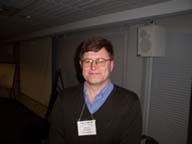 Acoustic
sensing with autonomous ocean sampling networks Return
to Top Acoustic
sensing with autonomous ocean sampling networks Return
to Top
Henrik Schmidt (Massachusetts Institute of Technology)
The rapidly emerging Autonomous Underwater
Vehicle (AUV) technology has the potential of dramatically improving the
capabilities for accurate and reliable forecasting of the physical and
biological ocean environment. Thus, the multi-AUV Autonomous Ocean Sampling
Network (AOSN) adds to the traditional measurement resources a rapidly
deployable measurement capability which can be adaptively focused in a
specific geographical area. Combined with new coupled physical and biological
modeling and data assimilation frameworks, the AOSN has lead to the develoment
of new ocean observation paradigms such as LOOPS (Littoral Ocean Observation
and Prediction System) for environmental assessment. Even though acoustics
is crucial to the navigation and communication within the AOSN and active
sonars are the most important sensors for seabed mapping, acoustic sensing
of the ocean volume has not yet been adequately developed to be suitable
within the AOSN framework. On the other hand, the AUVs have been proven
as excellent passive acoustic platforms, e.g. as bi-static receivers for
bottom surveys, and the AOSN may therefore have potential as a tool for
passive acoustic imaging of schools of vocal fish. Here the LOOPS and
AOSN concepts are described, and state-of-the-art in acoustic sensing
using AUVs is reviewed, and the potential of this new technology for fish
stock assessment is discussed.

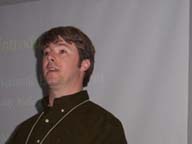 Quantifying
Species-Specific Contributions to the Overall Sound Level
Return to Top Quantifying
Species-Specific Contributions to the Overall Sound Level
Return to Top
Mark W. Sprague (Department of Physics,
East Carolina University) and Joseph J. Luczkovich (Department of
Biology/Institute for Coastal Marine Resources, East Carolina University)
The sound pressure level of an individual
or an aggregation can be used to estimate distance to an individual or
the size of the aggregation. When several sources are present, the sound
pressure level depends on the number of individuals calling as well as
the distribution of the sources. When a sound is over 10 dB greater than
the background, the background contribution to the total sound pressure
level is negligible. A simple correction factor may be subtracted from
the total sound level to obtain levels for sounds 3--10 dB above the background.
For short duration sounds, the total sound pressure level of a short time
segment in which the sound dominates can be used. Contributions due to
long-duration sounds--such as fish aggregations--can be obtained by summing
frequency bands of the power spectrum over which the desired source is
dominant. This spectral band level is an indicator of the loudness of
the sound of interest and, thereby, an indicator of other properties on
which the loudness depends. Spectral band levels for spawning aggregations
of weakfish Cynoscion regalis and silver perch Bairdiella chrysoura correlate
with species-specific egg samples taken at the same time and location.
Also, spectral band levels of silver perch can be used to determine their
reactions to bottlenose dolphin Tursiops truncatus whistles. When more
than one source contributes to a spectral band, possible techniques include
short time-windowed spectral bands or wavelet filters that reduce contributions
of the unwanted source.

 The
application of passive acoustics to assess, monitor, and protect the coral
reef ecosystems of the U.S. Pacific Islands Return
to Top The
application of passive acoustics to assess, monitor, and protect the coral
reef ecosystems of the U.S. Pacific Islands Return
to Top
Russell E. Brainard (NOAA Fisheries - Honolulu Laboratory), Kevin B. Wong*(NOAA
Fisheries - Honolulu Laboratory), Joseph J. Luczkovich (East Carolina
University), and Mark W. Sprague (East Carolina University)
The programs and activities of the NOAA Fisheries Honolulu Laboratory's
Coral Reef Ecosystem Investigation (CREI) are presented and areas where
the application of passive acoustic methods may significantly contribute
to scientific, management, and operational objectives are highlighted.
A call for additional collaborators to help undertake some of this work
is put forth. In addressing the two fundamental themes of The National
Action Plan to Conserve Coral Reefs, to understand coral reef ecosystems
and reduce adverse human impacts, the CREI was established to assess,
monitor, map, restore, and protect the coral reef ecosystems of the U.S.
Pacific Islands. CREI activities include rapid ecological assessments
of fish, corals, algae and invertebrates, towed diver digital video habitat
and fish surveys, acoustic seabed classification surveys, towed video
and still camera surveys, and in-situ and satellite remote sensing observations
of oceanographic conditions. The in-situ oceanographic observations include
closely spaced conductivity-temperature-depth-chlorophyll casts, acoustic
Doppler current profiler surveys, long-term moored oceanographic buoys,
surface velocity drifters, and APEX diurnally migrating profiling drifters.
While the oceanographic moorings and satellite remote sensing allow high
temporal resolution monitoring of the physical processes driving these
ecosystems, the remoteness of these ecosystems prevents adequate temporal
monitoring of the biological responses (surveys can only be conducted
at 1-2 year intervals). We propose to develop passive acoustic techniques
to monitor some aspects of the health of these remote ecosystems and to
develop warning systems to alert scientists and resource managers of large
changes or potential threats. Passive acoustic techniques are also proposed
to monitor vessel traffic and illegal incursion into marine protected
areas.

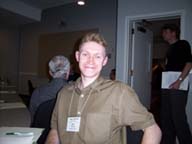 Classifying
fish sounds using wavelets Return
to Top Classifying
fish sounds using wavelets Return
to Top
Mark Wood (Dept. of Mathematical Sciences, Univ. of
Aberdeen)
Wavelets have become increasingly popular since the 1980's, when rapid
developments were made in giving the subject a formal mathematical framework.
They have been applied in many different fields including signal and image
processing, speech recognition, physics and engineering. Wavelets provide
a set of time and scale varying basis functions for representing signals,
very often extracting more information than the familiar Fourier transform.
This talk considers the problem of discriminating
between fish sounds to automatically recognise individual fish and different
species of fish. Properties of the discrete wavelet transform are used
to remove noise and isolate individual sounds. The stationary wavelet
transform is then used to derive features for discrimination. Results
from experiments to classify individual haddock and separate different
species of fish will be presented.
This work enables biologists to relate sound
production with fish behaviour through simultaneous video recordings,
and the method may also provide a non-invasive technique for locating
fish spawning grounds in the sea.
Return to Top
|
